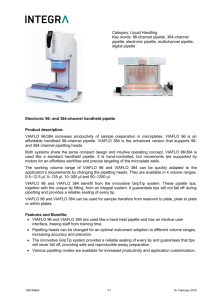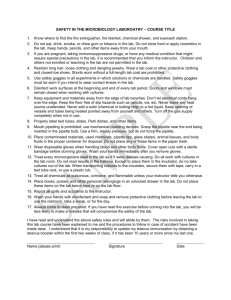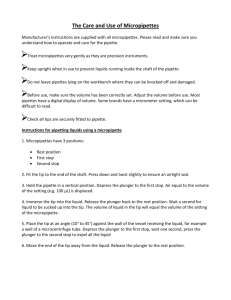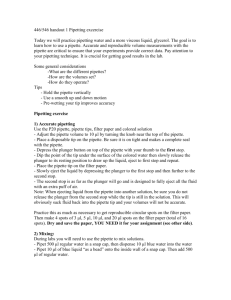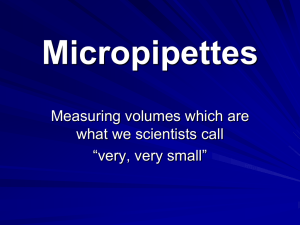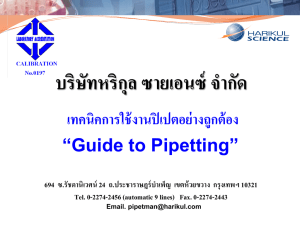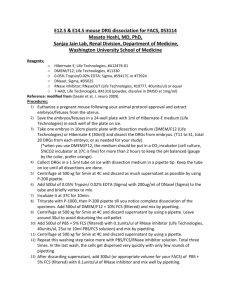Lab Report2.qxp
advertisement
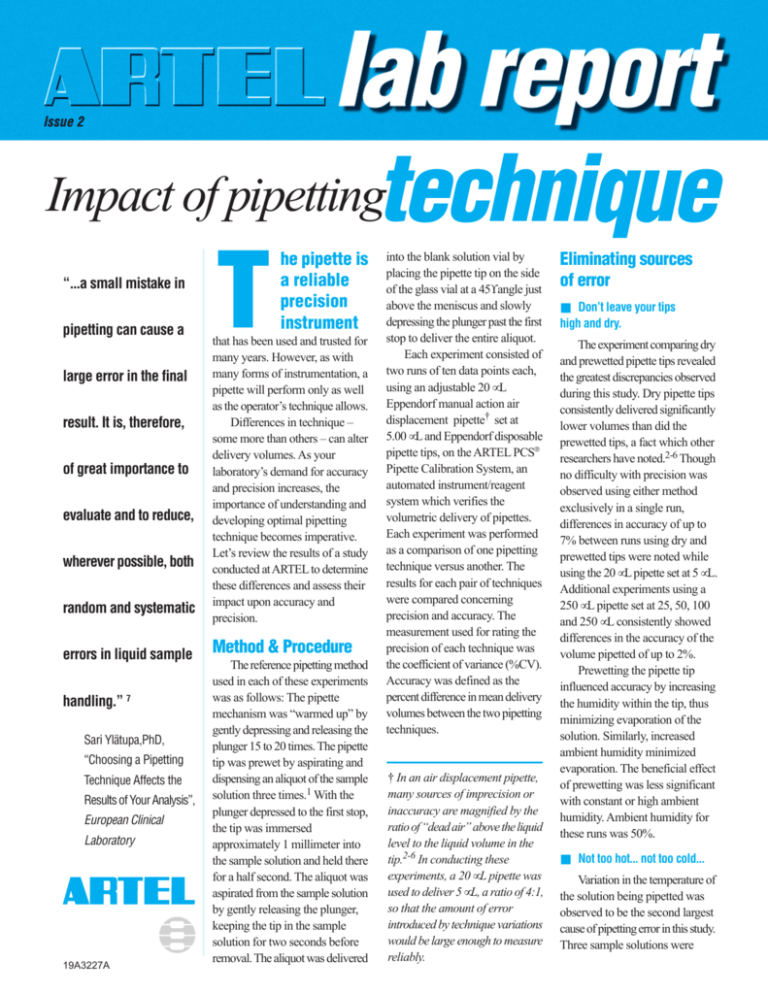
technique Impact of pipetting “...a small mistake in pipetting can cause a large error in the final result. It is, therefore, of great importance to evaluate and to reduce, wherever possible, both random and systematic errors in liquid sample handling.” 7 Sari Ylätupa,PhD, “Choosing a Pipetting Technique Affects the Results of Your Analysis”, European Clinical Laboratory 19A3227A T he pipette is a reliable precision instrument that has been used and trusted for many years. However, as with many forms of instrumentation, a pipette will perform only as well as the operator’s technique allows. Differences in technique – some more than others – can alter delivery volumes. As your laboratory’s demand for accuracy and precision increases, the importance of understanding and developing optimal pipetting technique becomes imperative. Let’s review the results of a study conducted at ARTEL to determine these differences and assess their impact upon accuracy and precision. Method & Procedure The reference pipetting method used in each of these experiments was as follows: The pipette mechanism was “warmed up” by gently depressing and releasing the plunger 15 to 20 times. The pipette tip was prewet by aspirating and dispensing an aliquot of the sample solution three times.1 With the plunger depressed to the first stop, the tip was immersed approximately 1 millimeter into the sample solution and held there for a half second. The aliquot was aspirated from the sample solution by gently releasing the plunger, keeping the tip in the sample solution for two seconds before removal. The aliquot was delivered into the blank solution vial by placing the pipette tip on the side of the glass vial at a 45° angle just above the meniscus and slowly depressing the plunger past the first stop to deliver the entire aliquot. Each experiment consisted of two runs of ten data points each, using an adjustable 20 µL Eppendorf manual action air displacement pipette† set at 5.00 µL and Eppendorf disposable pipette tips, on the ARTEL PCS® Pipette Calibration System, an automated instrument/reagent system which verifies the volumetric delivery of pipettes. Each experiment was performed as a comparison of one pipetting technique versus another. The results for each pair of techniques were compared concerning precision and accuracy. The measurement used for rating the precision of each technique was the coefficient of variance (%CV). Accuracy was defined as the percent difference in mean delivery volumes between the two pipetting techniques. † In an air displacement pipette, many sources of imprecision or inaccuracy are magnified by the ratio of “dead air” above the liquid level to the liquid volume in the tip.2-6 In conducting these experiments, a 20 µL pipette was used to deliver 5 µL, a ratio of 4:1, so that the amount of error introduced by technique variations would be large enough to measure reliably. Eliminating sources of error ■ Don’t leave your tips high and dry. The experiment comparing dry and prewetted pipette tips revealed the greatest discrepancies observed during this study. Dry pipette tips consistently delivered significantly lower volumes than did the prewetted tips, a fact which other researchers have noted.2-6 Though no difficulty with precision was observed using either method exclusively in a single run, differences in accuracy of up to 7% between runs using dry and prewetted tips were noted while using the 20 µL pipette set at 5 µL. Additional experiments using a 250 µL pipette set at 25, 50, 100 and 250 µL consistently showed differences in the accuracy of the volume pipetted of up to 2%. Prewetting the pipette tip influenced accuracy by increasing the humidity within the tip, thus minimizing evaporation of the solution. Similarly, increased ambient humidity minimized evaporation. The beneficial effect of prewetting was less significant with constant or high ambient humidity. Ambient humidity for these runs was 50%. ■ Not too hot... not too cold... Variation in the temperature of the solution being pipetted was observed to be the second largest cause of pipetting error in this study. Three sample solutions were brought to three different temperatures: 8.5 °C, 25.0 °C, and 30.0 °C. Solutions that were warmed to 30.0 °C consistently delivered lower volumes than room temperature samples. Similarly, solutions that were cooled to 8.5 °C delivered higher volumes than the ambient (25.0 °C) sample. The accuracy differences observed in this study were significant, ranging from 3 to 7%. The graph below shows the effect of sample temperature on pipetting accuracy. In addition to accuracy problems seen with samples that were not at room temperature, there was some difficulty in obtaining good precision. Runs typically produced between 0.50 % and 1.00 %CV, although the %CV went as high as 3.60. As the solution was allowed to approach room temperature, the precision of the results improved. Similarly, if the pipette end or tip was warmed, even just by casual handling, differences in delivery volumes were observed. These differences and inconsistencies were smaller and less significant than those resulting from variations in solution temperature. ■ Shift out of Reverse Reverse mode pipetting is a method of pipetting commonly used with viscous liquids. This is a technique in which the plunger is depressed past the first stop to aspirate the aliquot from the sample, and depressed only to the first stop to deliver the aliquot. Reverse mode pipetting can make obtaining accurate and precise results (for the pipetting of solutions similar to water in terms of density and surface tension) more difficult. The study showed that a typical precision for this method was 1.4 %CV. Differences in volumes delivered by standard and reverse mode techniques ranged up to 5%. The reverse mode consistently delivered a higher volume than the standard method of pipetting. &Answers What are other techniques which can affect accuracy and precision? Other error causing techniques noted in this study included: a. prolonged delay between aspiration and removal of the tip from the sample b. dragging the tip along the side of the container when the tip is exiting the sample c. variations in the size and shape of the sample container, and d. rate of plunger depression and release. What impact will these techniques have upon my results? Individually none of these factors resulted in an error greater than 2%. Cumulatively, however, two or more of these sources of error (e.g., prolonged delay and rate of plunger depression) could affect delivered volume significantly. ■ Conclusions What factors other than technique differences can affect my results? Techniques among pipette users vary with background, personal preferences, and training. These differences in execution can affect the accuracy and/or the precision of results being released from the clinical or research lab. To ensure accuracy and consistency, facilities should adopt standard operating procedures for pipetting techniques and ensure that all operators are trained to an adequate level of proficiency. By increasing the level of consistency in results obtained, the level of quality and credibility of the facility will be enhanced. Component failure (e.g., a plunger seal or corroded piston), incorrect pipette tip, or incorrect installation of the tip can also affect your results. Effects of Sample Temperature on Pipetting Accuracy References: 1 Zeman GH, Mathewson NS. “Necessity of prerinsing disposable polypropylene pipet tips”, Clin Chem 1974; 20(4)497-8. 2 Sternberg JC. “Sampling with air-piston pipettes – a critical study”, Clin Chem 1975; 21(7):1037. 3 Ellis KJ. “Errors inherent in the use of piston activated pipettes”, Anal Biochem 1973; 55:609-14. 4 Wenk RE, Lustgarten JA. “Technology of manually operated sampler pipettes”, Clin Chem 1973; 20(3):320-3. 5 Joyce DN, Tyler JPP. “Accuracy, precision and temperature dependence of disposable tip pipettes”, Med Lab Technol 1973; 30:331-4. 6 Lochner KH, Ballwegt, Fahrenkrog HH. “Factors influencing the measuring accuracy of piston pipettes with air interface (German)”, J. Lab Med 1996; 20(7/8)430-440. 7 Ylätupa Dr. S. “Choosing a Pipetting Technique Affects the Results of Your Analysis”, European Clinical Laboratory 1996. 10:14. lab report © is published by Artel, Inc. for laboratory professionals and all pipette users. For more information, please contact Artel, Inc. Experiment showing the effect of sample temperature on the accuracy of pipetting results, using a 20 µL adjustable air displacement pipette set at 5.00 µL. Ambient temperature 25.0 °C. Tel: 207-854-0860 Email: post@artel-usa.com Fax: 207-854-0867 Web: www.artel-usa.com 25 Bradley Drive, Westbrook, Maine 04092-2013
